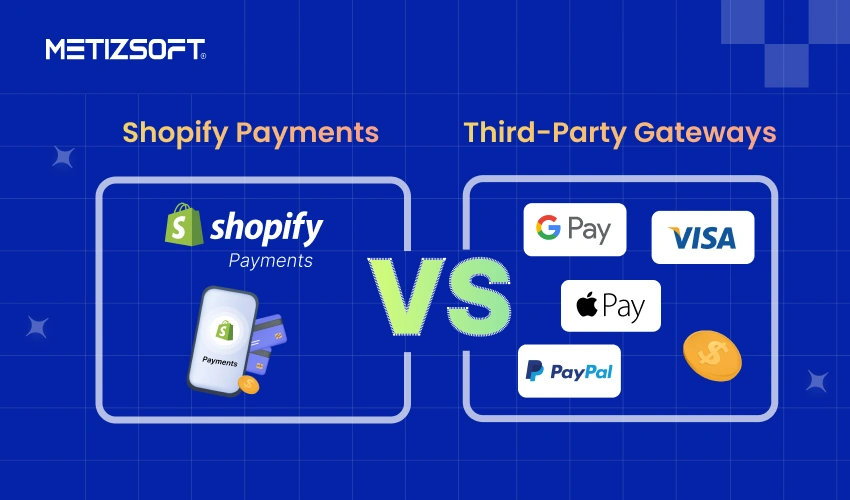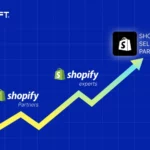
Table of Contents
Introduction
Digital, UPI, and cashless payments have emerged as game-changing solutions for seamless transactions. In contrast, Shopify emerges as a trustworthy companion with advanced and easy-to-use payment gateways for the eCommerce realm. But Shopify doesn’t run the show alone; it has tight competition in the name of robust third-party gateways.
This competitor turned out to be the powerhouse and drove a greater user base with its unique offerings. Since then, the comparison between Shopify payment vs Third-party gateways has grabbed the central stage amongst merchants and businesses worldwide.
Let’s discover key insights into Shopify payment and third-party payment gateways, including their key features, pros, and cons, to find out which one might be a good option for your business.
What is a Payment Gateway?
A payment gateway connects customers and businesses when money is changing hands. It helps make sure that when you buy something online or in a store using a credit card or any digital payment method (like a mobile wallet), the transaction details are handled safely and correctly.
Online payment gateways are software programs that run on the internet (in the cloud). For stores where you pay in person, the payment gateway is usually part of the cash register or point-of-sale (POS) system.
What are the Different Types of Payment Gateways?
Hosted Payment Gateways: This is the direct method that most of us have explored. For example, you’re shopping online, ready to checkout, and suddenly, you’re switched to a different, super secure-looking website to enter your payment info. That’s a hosted gateway at work. It’s like a quick, safe side trip to complete your payment.
Self-Hosted Payment Gateways: This one is famous for making payments super easy for users. When you shop, you just feed your credit card details right into the store’s website. It feels like you’re doing everything in one simple step.
Non-Hosted Payment Gateways: In this case, the business does everything payment-related – collecting and processing your details on its own website. This is also known as the DIY approach, the most involved method, and is usually only used by larger companies that have the technical know-how to pull it off.
Shopify Payment: Features, Pros and Cons
Shopify Payments is Shopify’s built-in way for you to accept payments. You don’t need to sign up with any other payment companies. Partner with a reliable Shopify development agency, and they will take care of the procedure. It’s all part of Shopify, and they will make it super easy to manage your sales, get your money, and handle anything payment-related, all from one place.
Shopify Payment Key Features
- Easy Integration: Shopify comes “built into the Shopify platform, requiring no additional configuration” means. It’s already part of the system, so you don’t have to do any extra setup for it.
- Fast Payout: All your earnings will be directly transferred to your account within two business days. Shopify has made sure to create a quick and efficient process to avoid waiting time!
- Cost-effective: If you use Shopify Payments, you won’t have to pay any extra fees for each transaction. Other payment systems often charge these extra fees, but Shopify Payments doesn’t. So, you save money by using their built-in system.
- Advanced Security: Shopify comprises built-in security features that help prevent fraud. This means we’re working behind the scenes to keep your store and your customer’s information safe.
- Advanced Analytics: The leading eCommerce platform has built-in advanced analytics, which lets you access, generate, and analyze all your customer reports in a few clicks. You will get all data coverage in your dashboard.
Pros
- Quick & Convenient: Using Shopify’s Payment Gateway is super easy and convenient. It means you don’t need a separate payment processor for your store, which saves you time and makes things simpler.
- Multiple Payment Method: Shopify gladly accepts all major credit and debit cards. The leading eCommerce platform also offers alternative payment options, including Apple Pay and Google Pay.
- No Additional Transaction Fee: Shopify won’t charge any extra fees using their payment system. You’ll only pay the usual fees your credit card company charges.
- Seamless Integration: Shopify now includes its own Payment Gateway that works seamlessly with your Shopify Store, giving your customers a really smooth checkout experience.
- Agile Customer Support: One of the best things about Shopify is their 24/7 customer support. It’s always there when you need it, and you can quickly contact them via email, live chat, or by calling their hotline.
Cons
- Limited Geographical Coverage: Right now, only certain countries, like Australia, Canada, Denmark, Germany, Hong Kong, and a few others, can use Shopify’s payment gateways.
- Limited Features: Shopify Payments is good for simple dealings but lacks some sophisticated merits that third-party payment providers, like detailed analytics, custom billing, etc., may offer.
- Less Compatibility: Compared to some third-party ones, you might find Shopify Payments less adaptable to some forms of unique business models or complex payment processes.
Third-Party Payment Gateways: Features, Pros and Cons
You must have heard or used different payment options like PayPal, Stripe, or Authorize.Net. These are separate companies that work with your Shopify store to process payments. They can be a good choice for some businesses, offering more flexibility.
Third-Party Payment Gateway Key Features
- Flexible Payment Option: Payment gateways like PayPal and Stripe can help. They support many different currencies and countries, making international sales easier.
- Improved Features: Companies like PayPal, Stripe, and Authorize.Net offer their own payment systems that can connect to your Shopify store.
- Reliability: Many third-party payment option providers have extra features, such as subscription billing, customized checkouts, and detailed financial reports.
Pros
- Global Reach: Payment gateways like PayPal and Stripe work in many countries and use different currencies, making international sales easier.
- Extended Features: They also often provide extra features like detailed reports on your sales, recurring billing for subscriptions, and flexible payment options.
- Flexibility: Customers widely recognize and trust popular payment methods like PayPal and Stripe. This results in higher conversion rates since customers feel secure using payment methods they are familiar with.
- Customization: Third-party payment gateways offer flexible customization to meet unique business needs.
Cons
- Higher Transaction Fees: In third-party payments, sometimes, customers are moved to a different website to pay, which can make the checkout process a little less smooth and might cost more.
- Complex Setup and Management: Integrating third-party gateways often requires more effort. You may need to create an account with the provider, enter API credentials, and manage the payment process outside of the Shopify platform.
- Checkout Process Disruption: Some third-party gateways can disrupt the seamless checkout experience by redirecting customers to an external site for payment. Although there are plugins that can integrate third-party gateways into the same page, this can still be an inconvenience for customers.
Shopify Payments vs Third-Party Gateways: Which Payment Solution is Best for Your Business?
Whether you go with Shopify Payments or a payment gateway from a third party really comes down to what your business needs, how much you’re looking to spend, and who you’re trying to reach. If you want a payment system that just works seamlessly within Shopify and you need to cater to international customers using different currencies, Shopify is probably your best bet. All you need to do is hire Shopify experts to perform seamless execution!
But, if your online store needs specific features that Shopify’s payment system doesn’t provide, then a third-party payment gateway is your one-size-fit solution. There are plenty of well-known options out there, and a large user base filled with unified features makes them a comfortable choice for setting up and managing external integrations.
Final Takeaway
Picking the right payment method is super important for your Shopify store. Whether you use Shopify Payments (which works smoothly with Shopify) or any third-party payment gateway, make sure it fits your business, what your customers want, and how you run things.
But, to ensure seamless execution and make your Shopify store shine, you need expert assistance at the forefront. We at Metizsoft use our skills and know-how to build amazing stores with appropriate payment systems. Contact us today for a FREE consultation!
Related Posts
Shopify Partners India Attending Global eCommerce Expo-Mumbai 2018
Metizsoft Solutions attending the Great India e-commerce Expo-Mumbai 2018 as a Reputed Shopify Partner in India. Global...
10+ Advanced Shopify Plus Features & What They Offer?
Table of Contents IntroductionShopify Plus Advanced Feature ListsShopify Plus Partner ProgramIt’s a Wrap Up...

